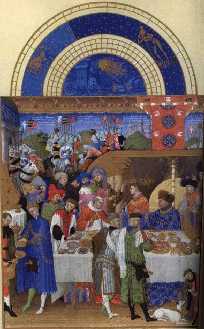 WEMSK16:Time and Calendars
WEMSK16:Time and Calendars
 WEMSK16:Time and Calendars
WEMSK16:Time and Calendars
WEMSK16
The calendar is based for the most part on recurrence of natural
phenomena, mostly astronomical, so it is in part easy to deal with
with a computer, since these recurrences are governed by strict
scientific laws. What makes it hard is that the medieval view
was
geocentric, and they weren't anything like as finicky as we are.
You must remember that not all medievals followed the same
calendar, so that their dates may be far off from ours. You need
to realize that mostly they used a church calendar, and that the
names most frequently used are things like "Quasimodo" (= quasimodo
geniti, the first words of the introit of the mass for Low Sunday
[first Sunday after Easter]), so that it is well to sort of get
used to this way of naming dates, along with the pericope system,
indicating the readings for the day. This is a large subject, so
take it slow. Just the literature of Dyonysius Exiguus and the
Easter Cycle is enormous. You will probably be using the
electronic tools available (see below), but you need to know about
the others, too.
For learning about the medieval way of handling time, you cannot
beat Bede. See C. W. Jones, Bedae Opera de Temporibus. Medieval
Academy Publ. 41 (Cambridge: Med. Acad., 1943). Reading through
this will give you a feel for how they did it in the Middle Ages.
Another way to get such a feel is to read one of the modern works
on calendars, rigamaroles, etc., such as George Nichols Packer, Our
Calendar (Williamsport, PA: Blank, 1890). Besides such things as
our "Thirty days hath September ...", you will learn rigamaroles to
tell you which day each month begins with: "At Dover Dwells George
Brown, Esquire / Good Carlos Finch, and David Fryer." This is the
way they had to do the calendar in the Middle Ages, along with
counting off on the fingers, Cisiojanus-wise.
Bibliography
1. Your first port of call should be: Hermann Grotefend,
Taschenbuch der Zeitrechnung des deutschen Mittelalters und der
Neuzeit, 11th ed, by Th. Ulrich (Hannover: Hahn, 1971). Good,
practical binding; good intro. I would buy this one.
2. For general information on time reckoning: Martin P. Nilson,
Primitive Time-Reckoning, 2d ed. (Lund: Gleerup, 1960; reprint of
1920 ed.).
3. If you do not want to do a lot of calculating and thinking, an
excellent book is: Louis Mas-Latrie, Tresor de chronologie
d'histoire et de geographie pour l'etude et l'emploi des documents
du moyen age (Paris: Palme, 1889; repr. Turin: Bottego d'Erasmo,
1962). In its 2300 columns, it contains dates and charts on just
about everything. Based on the old L'art de verifier les dates.
4. Another compendious list of dates and tables: Friedrich Karl
Ginzel, Handbuch der mathematischen und technischen Chronologie:
Das Zeitrechnungswesen der V”lker, 3 vols. (1906-14; repr. Leipzig:
Hinrichs, 1958).
5. The standard work is: Hermann Grotefend, Zeitrechnung des
deutschen Mittelalters und der Neuzeit, 3 vols. (Hannover: Hahn,
1891-98; repr. Aalen: Scientia Verlag, 1970. It is well to xerox
off parts and bind them.
6. A very handy, small book, mostly with charts, a little hard to
use at times: Hans Lietzmann, Zeitrechnung der roemischen
Kaiserzeit, des Mittelalters und der Neuzeit fuer die Jahre 1-2000
nach Christus. Sammlung Goeschen 1085 (Berlin: de Gruyter, 1946).
7. If you like to work things out yourself and want to know how to
do it: Bryant Tuckermann, Planetary, Lunar, and Solar positions,
601 BC to AD 1649, at Five-day and Ten-day Intervals, 2 vols.
(Philadelphia: American Philosophical Society, 1962-64). We only
need volume 2, from 2-1649 AD. A great work; with a little
elementary math, you can map out the sky from downtown Copenhagen
in 450 AD.
8. On the other hand, if you want to make your own calculations:
a. Jean Meeus, Astronomical Formulae for Calculators. 4th ed.
(Richmond, VA: Willmann-Bell, 1988).
b. Duffett-Smith, Peter. Astronomy with your Personal Computer.
(Cambridge: Cambridge University Press, 1986).
c. Even if you do not know BASIC, you can learn the basic
algorithms from: Eric Burgess, Celestial BASIC. Astronomy on your
Computer (Berkeley: SYBEX, 1982).
9. It is important to realize that each tradition may have its own
calendrical problems. For Old Norse, for example, see: Martin
P.
Nilsson, Tideraekning. Nordisk Kultur 21 (Stockholm: Bonniers
Forlag, 1934).
a. For England, other than Bede, mentioned above: S. J. Crawford,
ed., Byrhtferth's Manual (A.D. 1011), EETS 177 (Oxford: OUP, 1929).
10. It is good to maintain a rough time line of ones own, along the
lines of the Kulturfahrplan (Timetables of History) or Brett-James'
The Triple Stream. I know of only one reliable (?) timeline for
literature: Raphael Levy, Chronologie approximative de la
litterature francaise du moyen age. Beihefte zur Zeitschrift fuer
romanische Philologie, Heft 98 (Tuebingen: Miemeyer, 1957), which
functions almost as a statement of the corpus of OFr. With a
computer, it is not difficult to construct and maintain a
comparative timeline.
Speaking of computers, much of the above can be gotten around by
using computer programs. I recommend two excellent ones, both
by
medtextlers:
1. Historical Calendar of Western Europe, by Bernd Kratz. More
European.
2. The Medieval Calendar, by Peter S. Baker. Leans toward England.
Great screens.
Both are available on the web from Mediev-L's site:
ftp:kuhub.cc.ukans.edu.
With these two, you almost do not need any of the above; you should
keep them on your hard disk and refer to them in time of need.